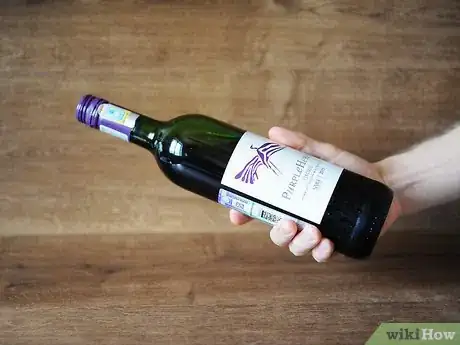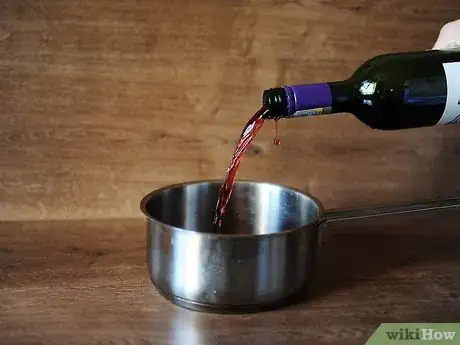This article was co-authored by Tom Blake and by wikiHow staff writer, Sophia Latorre. Tom Blake manages the bartending blog, craftybartending.com. He has been a bartender since 2012 and has written a book named The Bartender's Field Manual.
There are 9 references cited in this article, which can be found at the bottom of the page.
This article has been viewed 72,577 times.
Cold sangria is the perfect drink for warm summer nights, while hot sangria will warm you up on a frosty winter evening. The rich, complex flavors of fruit, wine, and liquor make for a delicious beverage any time of year! Sangria pairs well with seafood, spicy dishes, fruit and cheese plates, and even desserts.
Steps
Serving Cold Sangria
-
1Serve sangria from a pitcher or punch bowl. Choose a clear pitcher or punch bowl to showcase the beauty of the sangria. Choose a pitcher or bowl large enough fit an entire bottle of wine and to serve 8 drinks. Fill glasses by pouring them from the pitcher or use a ladle to fill glasses from a punch bowl.
- A dispenser is not a good choice for serving sangria, as the fruit can clog the spout.
-
2Allow it to soak for several hours before serving. After you make sangria, don’t serve it immediately. Let it sit anywhere from 4 hours to overnight to allow the fruit to soak up the flavors.[1]
- However, don’t add any seltzer or sparkling water until you’re ready to serve the sangria.
Advertisement -
3Serve sangria chilled or on the rocks. Sangria is best served chilled, so store it in the refrigerator in the serving container while the ingredients are soaking. Alternatively, you can serve it on the rocks by filling glasses with ice before pouring in the sangria.[2]
-
4Put sugar or spices on the rim of the glass. Dip the mouth of a glass in a shallow bowl of water. Then, dip the wet glass in a shallow bowl of sugar or spices that complement the flavors of the sangria. Fill the glass with sangria and enjoy!
- Spices you could use to rim the glasses include cinnamon, cayenne pepper, cocoa powder, or a mixture of them.
-
5Add a fruit or herb garnish to the sangria. Put cherries, cranberries, or raspberries on a pretty toothpick and stick it in the top of each glass. Alternatively, you could garnish the glasses with citrus slices, a few frozen blueberries, or a sprig of mint.
Serving Hot Sangria
-
1Serve hot sangria from the stovetop or a slow cooker. The best way to keep your sangria warm all through the evening is to let it simmer in a slow cooker (or crock pot). You could also allow it to simmer in a large pot or saucepan on the stovetop, if you don’t have a slow cooker.[3]
-
2Choose heat-resistant glasses for serving hot sangria. Rather than getting out your stemware, choose mugs for serving hot sangria. Not only will the mugs keep the sangria warmer than thin glasses, they also have a nice handle for holding on to the hot beverage.[4]
- Hot sangria could potentially crack thin glasses, so avoid using these to serve hot sangria.
-
3Let hot sangria simmer for 20 to 30 minutes before serving. You want all your spices and flavors to combine nicely, so this is an important step. Though you could simply heat the mixture and serve it, letting it simmer for a bit longer creates a more complex and nuanced flavor. Just be sure to keep the burner or slow cooker on a low setting.[5]
-
4Garnish the drink with fruit and a cinnamon stick. A cinnamon stick is the perfect garnish -- and stir stick -- for spicy, hot sangria. Pop 1 in each glass before serving. Add an apple or orange slice to the rim of the glass or pop a few fresh cranberries on top.[6]
Making Cold Sangria
-
1Start with a bottle of wine. Sangria can be made with red, rosé, or white wine. You don’t need an expensive bottle of wine to make a delicious sangria. In fact, a complex, expensive wine may compete with the flavors of the fruit and spices, so choose a simple, relatively cheap wine.[7]
- This recipe makes 8 servings.
-
2Choose a liquor and add 4 oz (118 mL). You can choose from brandy or fruit liqueur. You may even want to use 2 oz (59 mL) of brandy and 2 oz (59 mL) of a fruit liqueur, like orange, pear, or cherry. Select flavors that you think will pair well with the type of wine you’ve chosen.[8]
- For example, if you’ve chosen a wine with cherry undertones, choose cherry liqueur. Or, choose orange liqueur if your wine has notes of citrus.
-
3Chop up 2-3 cups (350-525 g) of fruit. Pick at least 1 citrus fruit and 1 non-citrus that will compliment the flavors in the wine and liquor you have chosen. Oranges, lemons, limes, or grapefruit are good choices for citrus fruits. Non-citrus fruit options include cherries, plums, cranberries, raspberries, or strawberries, which work best with red wines. Or use peaches, apples, or pears if you put white wine in your sangria.[9]
- Mix and match the fruits and don’t be afraid to choose several! You can use more or less than 2-3 cups (350-525 g) if you prefer.
-
4Mix and chill the wine, liquor, and fruit. Put the chopped fruit, wine, and liquor in a pitcher or serving bowl. Stir it well to combine the ingredients, then put it in the refrigerator. Allow your mixture to soak anywhere from 4 hours to overnight.[10]
-
5Add fruit juice or simple syrup, if desired. After your mixture has chilled, taste it. If you think it needs a little sweetness, add fruit juice or simple syrup. Start with only a small splash of simple syrup or fruit juice, and mix it well. Taste the drink again and add more, if desired.[11]
- Alternatively, you can add a flavored soda, like Sprite or 7Up, in lieu of adding a sweetener and a seltzer.
-
6Top with seltzer or sparkling water. The seltzer or sparkling water should be the last ingredient you add, as it will go flat if allowed to chill in the refrigerator for too long. When you’re ready to serve the sangria, add 1 cup (8 oz) of seltzer or sparkling water to the pitcher. Alternatively, pour sangria into individual glasses and top them off with seltzer or sparkling water.[12]
- You can choose from flavored or plain sparkling water or seltzer.
Making Hot Sangria
-
1Pour a bottle of red wine in a pot of slow cooker. Red wine is best for making hot sangria, so avoid using a white wine for this recipe. Choose a bottle with fruity undertones to complement the fruit you’ll add. Pour the entire bottle into a large pot or saucepan or into a slow cooker or crock pot.[13]
- This recipe serves 8.
-
2Add 3 cups (710 mL) of cider or juice and 0.5 cups (120 mL) of liquor. You can use apple cider and rum, or cranberry juice or orange juice and brandy. Adjust the amounts of cider or juice and liquor based on how strong or weak you like your sangria. Pour the cider or juice and liquor into the pot to meld with the wine.[14]
-
3Sweeten the sangria with honey or sugar, if desired. If you like your sangria sweeter, add 0.25 cups (59 mL) of honey to the pot. Alternatively, you can use 3 tablespoons (45 g) of sugar.[15]
-
4Add spices to create a richer flavor. You can add 2 or 3 cinnamon sticks, 4 to 6 whole cloves, 1 to 2 teaspoons (5.7 to 11.4 g) of nutmeg, and a few pieces of star anise. Mix and match the spices to your liking, or add 2-3 tablespoons (1-1.5 g) of mulling spices, instead. Give everything a good stir after adding the spices to the pot.[16]
-
5Put chopped fruit in the pot. Pick at least 1 citrus fruit (like orange or lemon) and 1 non-citrus fruit (like cranberries or apples). Add 1 cup (128 g) of chopped fruit to the pot.[17]
-
6Heat the mixture for at least 20 to 30 minutes. Turn on the burner or slow cooker to low heat and allow the mixture to simmer. Stir it occasionally to help all the flavors blend together. To keep it warm throughout the evening, let it continue to simmer on low, stirring occasionally.[18]
- Take care not to let the mixture boil, or you could end up with a sticky mess.
Pairing Sangria with Food
-
1
-
2
-
3Enjoy rosé sangria with a fruit and cheese plate. Select fruits that will match or complement the ones you put in your sangria, such as pears, figs, apples, or strawberries. Choose cheeses like brie, Roquefort, gorgonzola, and goat cheese. Don’t forget to add some crackers, too![21]
-
4Try hot sangria with mole. The spices and complex flavors in hot sangria pair well with rich and spicy foods like mole. A pepper and chocolate mole would be a great complement to hot sangria made with red wine and oranges.[22]
-
5Eat dessert with your sangria. The sweetness of sangria makes it a great drink to have with dessert. A fruity dessert, such as a fresh berry tart, baked apples, or poached pears in wine are perfect pairings.[23]
References
- ↑ https://familynano.com/how-to-serve-sangria/
- ↑ https://familynano.com/how-to-serve-sangria/
- ↑ https://thecrumbykitchen.com/hot-mulled-apple-cider-sangria/
- ↑ http://www.foodnetwork.com/recipes/bobby-flay/mulled-red-wine-sangria-recipe-1946657
- ↑ https://thecrumbykitchen.com/hot-mulled-apple-cider-sangria/
- ↑ http://www.southernliving.com/food/entertaining/party-perfect-sangria-recipes#warm-spiced-sangria
- ↑ http://www.epicurious.com/recipes-menus/how-to-make-sangria-without-a-recipe-article
- ↑ http://www.epicurious.com/recipes-menus/how-to-make-sangria-without-a-recipe-article
- ↑ http://www.epicurious.com/recipes-menus/how-to-make-sangria-without-a-recipe-article
- ↑ http://www.epicurious.com/recipes-menus/how-to-make-sangria-without-a-recipe-article
- ↑ http://www.epicurious.com/recipes-menus/how-to-make-sangria-without-a-recipe-article
- ↑ http://www.epicurious.com/recipes-menus/how-to-make-sangria-without-a-recipe-article
- ↑ http://www.foodnetwork.com/recipes/bobby-flay/mulled-red-wine-sangria-recipe-1946657
- ↑ https://thecrumbykitchen.com/hot-mulled-apple-cider-sangria/
- ↑ https://thecrumbykitchen.com/hot-mulled-apple-cider-sangria/
- ↑ https://thecrumbykitchen.com/hot-mulled-apple-cider-sangria/
- ↑ http://www.food.com/recipe/hot-cranberry-sangria-15524
- ↑ https://thecrumbykitchen.com/hot-mulled-apple-cider-sangria/
- ↑ http://bgeventsandcatering.com/tapas-and-sangria-food-pairings/
- ↑ http://bgeventsandcatering.com/tapas-and-sangria-food-pairings/
- ↑ http://lvpsangria.com/recipes-pairings/
- ↑ https://winefolly.com/tips/what-wine-goes-with-mexican-food/
- ↑ http://lvpsangria.com/recipes-pairings/
About This Article
Sangria is a delicious, fruity drink that can cool you off during summer and warm you up during winter. If you’re drinking sangria cold, serve it from a clear pitcher or punch bowl. Make sure you leave the sangria to soak for at least 4 hours so the fruit has time to soak up the flavors. If you’re adding sparkling water, leave this out until you’re ready to serve. Pour the sangria into glasses with ice. For a fancier presentation, put sugar or a spice, like cinnamon, cayenne pepper, or cocoa powder, on the rims. To serve hot sangria, let it simmer for 20 to 30 minutes so the spices and flavors can combine. Then, pour it into mugs or heat resistant glasses. For extra hosting points, add a cinnamon stick to each glass and garnish the edge with a slice of apple or orange. For more tips from our Bartending co-author, including how to make sangria from scratch, read on!

















































































